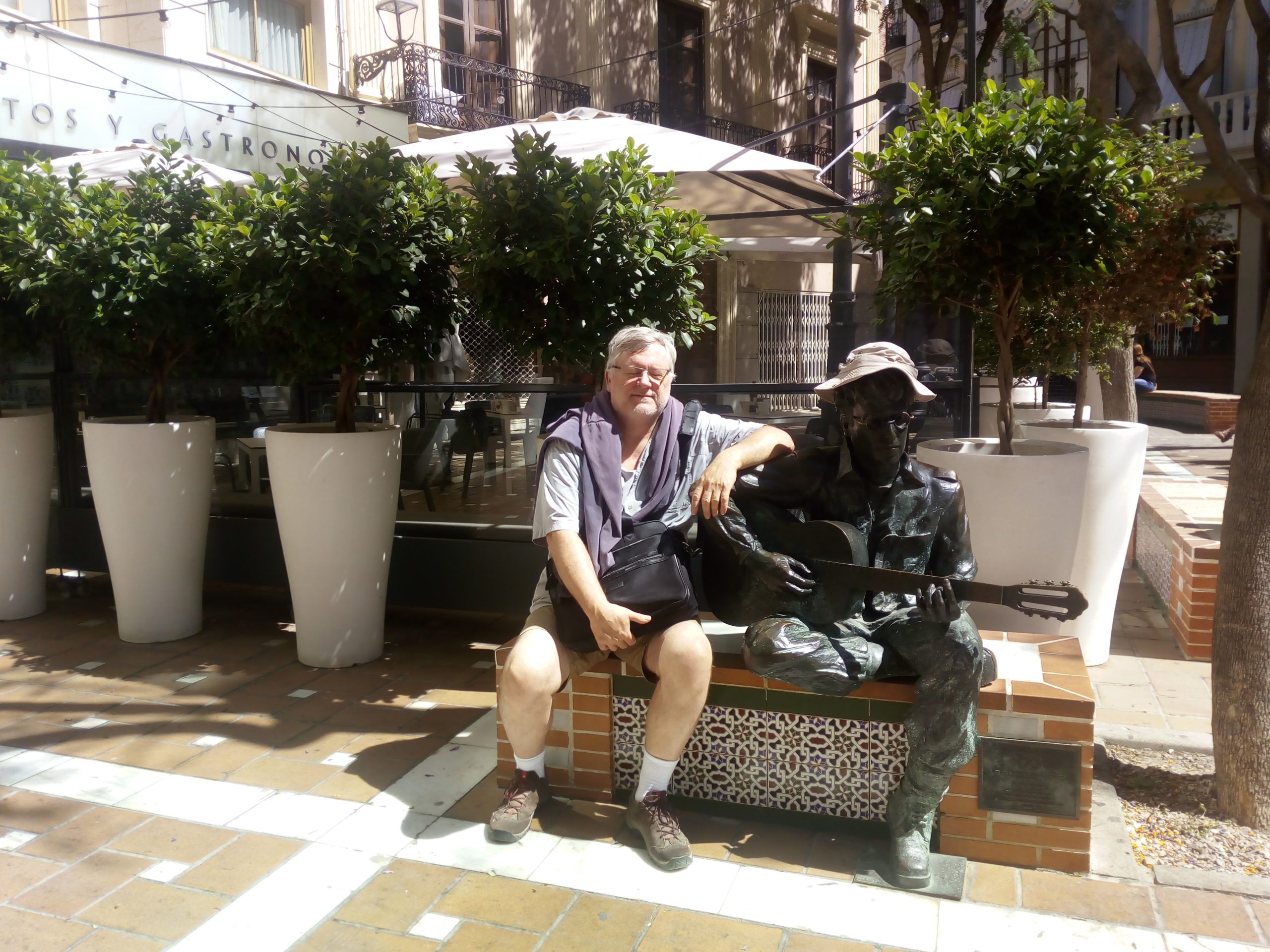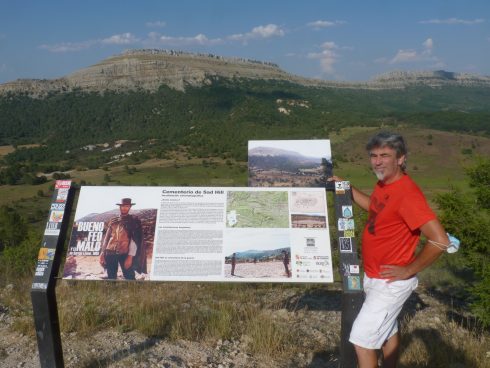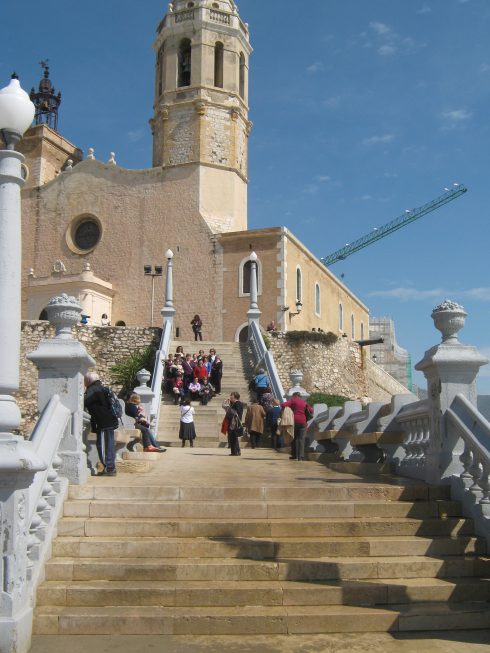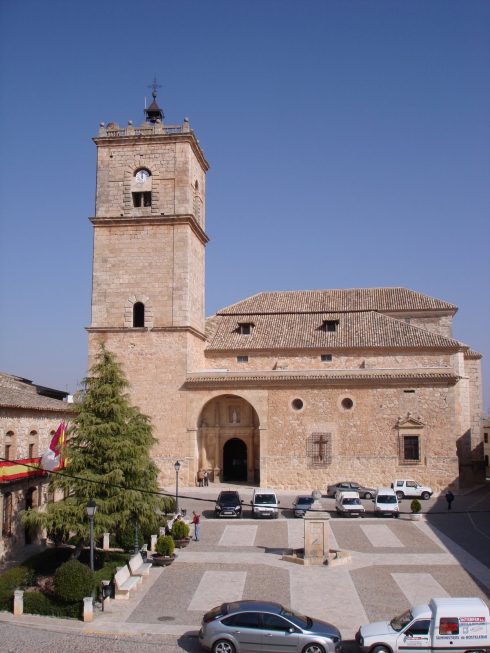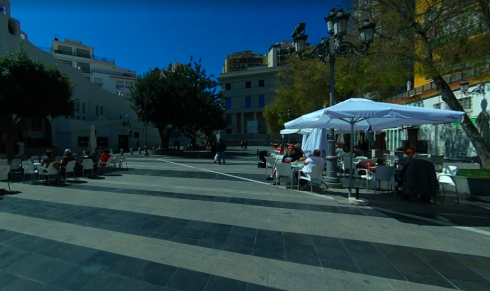Although he is probably best known for A Hard Day’s Night and his contribution to the Superman films, Richard Lester made seven movies in Spain, each of which is a minor classic.
For his first film here, A Funny thing Happened on the Way to the Forum (1966) the ‘ruins’ of the sets from ‘The Fall of the Roman Empire’ were still lying about at Las Matas near Madrid, enabling Lester to make this strange Roman parody. It seems dated today, but is the last film featuring Buster Keaton, who was dying of cancer at the time, but keen to revisit Spain, where he’d been in the thirties.
It was mostly made in the Bronston studios near Madrid, with some chariot ride scenes at La Pedriza, Madrid, and one scene, when Phil Silvers and his wife are off to visit her mother, where the town walls of Ávila can be seen in the background looking very post-Roman.
The forest that Keaton wanders through is the often used forest of Valsaín in Segovia.
The Roman aqueduct of Segovia also makes a brief appearance during the song ‘Everybody Ought to Have a Maid’ with a group of Romans parading across it singing.
At the end of the chaotic chariot pursuits towards the climax of the film, as a Captain rounds everyone up to take them back to Rome, a glimpse of Toledo and its Alcázar castle can be seen in the background, a view that Richard Lester would use again in his Musketeers Trilogy.
How I Won the War (1966) is interesting for many people as it marked the first performance on screen by John Lennon being something other than a Beatle.
Lennon played a Second World War soldier ‘Private Gripweed’, a name worthy of his own imagination. This was also the first time that the public saw Lennon wearing his Granny, or Trotsky (whichever way you lean) glasses.
Being a long way from home, and frequently bored, Lennon wrote one of his most emblematic songs, ‘Strawberry Fields Forever’ in Almería. Strawberry Field (as it is really called) was in fact an orphanage near his house in Liverpool, in whose garden Lennon played as a child.
The Spanish sections of the film, which were supposed to represent North Africa, were used for the most ‘English’ part of a surrealistic, funny film with a serious anti-war message.
The desert scenery used included Carboneras (in whose port they arrive in Africa), Cabo de Gata, Guardias Viejas and Tabernas, and the beaches of Matíl, Mónsul, Cala Príncipe and Mojácar.
As they set off on their journey across the desert Mesa Roldán castle appears briefly when the quaintly eccentric (or bloodthirstily mad) Grapple, played by Michael Hordern, shouts at his men from the top of it, inculcating military discipline and cricketing values.
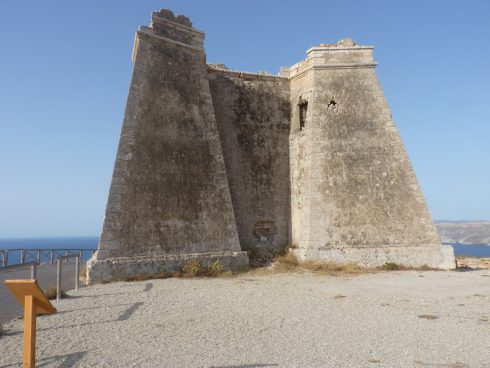
In the film the castle appears to be a round tower because it is seen from the side, although in fact it is considerably larger when seen from the front or back.
It also appeared in season 6 of Game of Thrones, episode 9, representing Meeren.
At the Rambla de Lanujar, the British are attacked by their own side, and at Rambla Otero they launch an incompetent attack on a German petrol dump.
The desert scenery and beaches of Almería in fact provided the battle scenes not only of the Battle of El Alamein, but also for the scenes representing Dieppe and Dunkirk (specifically this latter one at the Dunas de las Amoladeras at Cabo de Gata).
The hilarious scenes of a ‘crack’ (or ‘cracked’) unit of soldiers sent behind enemy lines with a roller to construct a cricket pitch (located at Rambla de Tabernas) were light years (journalistic language for ‘one or two’) ahead of their time, which may account for the film’s lack of commercial success.
The film is full of zany humour, which makes you unsure whether to laugh or ponder, as it was released at the time of the Vietnam War.
While in Almería Lennon stayed in an apartment block called ‘Delfín Verde’ (Green Dolphin) at the El Zapillo beach in Almería, Calle García Cañas 2, and he spent time in a nearby restaurant ‘El Manzanilla’.
With the arrival of Ringo to celebrate Lennon’s 26th birthday on October 9th, Lennon’s wife Cynthia insisted that they move somewhere bigger, and they ended up in a mansion called Santa Isabel (also known locally as Casa Romero), which was also rented at other times by actor Peter O’Toole, and producer Sam Spiegel. It was here and at the beach that Lennon wrote Strawberry Fields.
The gate of the mansion, which has now been converted into a multi-functional centre dedicated to the cinema and in remembrance of Lennon, used to bear a resemblance to the gate of the real (although ‘nothing is’) Strawberry Field, in front of which tourists regularly pose during Beatle nostalgia tours of Liverpool. Cynthia Lennon, who would later own a pub in Mallorca, claimed that she and Lennon believed the mansion to be haunted.
Lennon’s stay in Almería is commemorated by a statue of him playing his guitar, in Plaza Flores, by Spanish artist Carmen Mudarra, unveiled in 2006, which is usually draped by some sad tourist hoping a bit of talent will rub off.

Lennon’s violent death in the film is, with hindsight, a tragic irony, as he looks into the camera and berates us in that we knew this was going to happen. In fact, special effects maestro Eddie Fowler has commented that a condom full of false blood was exploded on Lennon’s chest to achieve dramatic effect.
Lennon’s connection with Spain didn’t finish there. He returned to Spain, or more specifically as the song ‘Ballad of John and Yoko’ says to Gibraltar near Spain, to get married to Yoko Ono on the 20th March 1969, and four days later had lunch with the father of Surrealism, Catalan painter Salvador Dalí in Paris.
A Spanish film, ‘Vivir es Facil con los Ojos Cerrados’ tells the story of a Spanish English teacher driving to Almería in search of Lennon. The film’s title is a line from Strawberry Fields.
The Three Musketeers (1973)was the first of Lester’s trilogy, a humorous version of the Dumas classic. Although intended as a single film, it finally became two, with the resulting law suits from disgruntled actors.
The royal palace of Aranjuez near Madrid made a believable substitute for Versailles, having been built in 1722 when Spain was just getting used to Frenchified ways under the newly installed Borbon dynasty following the War of Spanish Succession. Another old favourite, the royal summer retreat, La Granja, Segovia, also served as Versailles, and was also built by the first Borbon monarch Felipe V, while the Alcázar of Segovia was used as the scene of Charlton Heston’s ‘benevolent’ torturing of Spike Milligan.
Talamanca de Jarama, another popular filming location, has a Roman bridge, where Roy Kinnear collides with a tree and falls from his horse. A cruel irony as in ‘The Return of the Musketeers,’ also shot in Spain, a fall from a horse would lead to his death.
Other places where filming took place are the Riofrio Palace, the monastery of Uclés, Cuenca (where we can see Charlton Heston as Cardinal Richlieu scheming in front of the portal and in the cloister.
The four Musketeers come together for the first time to fight each other in duels but end up uniting to fight the Cardinal’s men among the washing lines tied to the well in the cloister of the Hospital de Tavera in Toledo.
The brief port scenes were shot during August and September 1973 in Denia in Alicante province, and in fact, when Michael York calls out that he has at last spotted Dover, he is in front of Cap (Cape) de Sant Antoni.
The Dover port scenes were shot at the dockside, whereas the port of Calais was represented at nearby El Raset, with the black façade of the ‘Cofradía de Pescadores’ (Fishermen’s Building) in the background.
The battle scene takes place on Almería’s Playa del Algarrobico, where Lawrence of Arabia took Aqaba.
In another scene the Musketeers fight with the Cardinal’s men and Oliver Reed has a problem with a windmill in the Cañon de Rios Lobos, a canyon in Soria and Burgos provinces.
The medieval cobbled streets of Toledo are easily recognisable as the Duke of Buckingham is pursued to a vaulted wash house, where he is defended by the Musketeers against Cardinal Richlieu’s men.
The Four Musketeers (1974). They cheated a bit by releasing this as a separate film, although it was made at the same time as The Three Musketeers (Oliver Reed, Frank Finlay and Richard Chamberlain) and used Carboneras, Garrucha and Almería among other locations. The shooting in Almería included the landmark Alcázaba castle.
In Segovia Raquel Welch, D’Artagnan’s bit on the side, is held in the Alcázar castle, or at least we see its façade, and when rescued by the Musketeers, is taken to a convent, which is in fact (at least the façade) the Escorial royal palace, just outside Madrid. However, when she escapes on stilts with the help of three of the Musketeers, she is in fact crossing the courtyard of the Christian part of the Alcazaba of Almería, quite a way away.
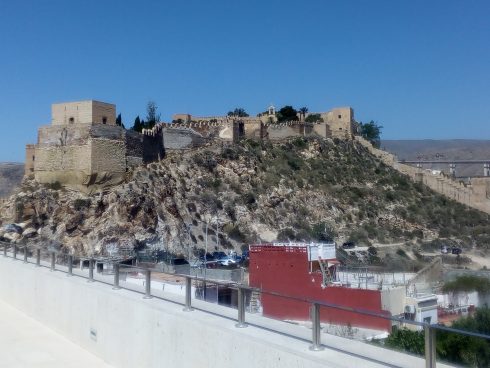
Also in Madrid the tavern scenes were once more shot in the Cartuja at Talamanca de Jarama, an old monastery whose grounds have been used in many films.
The brief port scenes, including the assassination of the Duke of Buckingham (Simon Ward) and Milady’s return to France after plotting his demise, were shot at the dockside in Denia, Alicante.
For the scenes of the siege of La Rochelle, the beach scenes were shot at La Raset Beach to the north of the port of Denia. The British soldiers were in fact mostly Spanish soldiers from a regiment based in nearby Alcoy.
The beach scenes were cunningly merged in an early example of digital inserting with the castle and wall representing La Rochelle. When the boys light-heartedly assault La Rochelle, as an excuse for breaking their fast, they are in fact attacking the hilltop castle of Berlanga de Duero in the province of Soria.
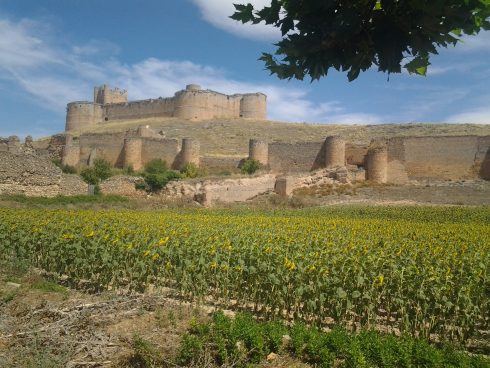
Filming took place here in August 1973 and History student Roberto de Pablo showed us around the castle and the southern ramparts where the scenes of the Musketeers were shot in August 2015.
Roberto’s father, Jesús, who runs the Hotel Villa de Berlanga, was one of the extras who earned 150 pesetas a day to counter attack the Musketeers.
The Musketeers have their showdown with Rochefort and Milady at the Monastery of Uclés in Cuenca province, with fighting scenes in the exterior, the courtyard, the staircase and the chapel. The bits they burnt were only a set fortunately.
At the end of the film, when the body count is completed and D’Artagnan, achieves a kind of reconciliation with Cardinal Richlieu, he leaves the Cardinal’s quarters and we see him among the arcades in the grounds of the Aranjuez palace.
Robin and Marian (1976). Sherwood Forest’s theme park would today probably detract from the area’s authenticity, and even in the mid seventies Richard Lester chose the unspoilt Orgi wood, an 80-hectare oak grove more than 4,000 years old, now a Recreational Nature Zone, to portray Sherwood.
On our visit to the park we saw a tree that looked suspiciously like the one that Denholm Elliott and Ronnie Barker fall out of onto the Sheriff’s men, but that might just be wishful thinking.
Lester commented that the area looked like everyone’s idea of what England looked like in the twelfth and thirteenth centuries. The glades among the oaks where Robin acts out his second childhood do indeed seem to be as idyllic and halcyon as an English country beer garden.
In Lisazo we met Manolo el Herrero (the Blacksmith), whose father and grandfather had indeed exercised that profession. Manolo was one of many local people who turned up looking for work and glory, and who was chosen to be Sean Connery’s stand-in for when the scenes were being prepared.
Although most of his time was spent with Audrey Hepburn’s stand-in, he did once get to sit down with the lady herself, and witnessed the strange fact that when she washed her hands, it was with bottled mineral water.
Sherwood was in fact played by two different forests in Navarra, the mountainous Quinto Real on the way north to Roncesvalles, was also employed, particularly when Robin and John are watching King Richard’s funeral procession.
The procession passes through an arid area, which is in reality a magnesium quarry five kilometres from Eugui in the Valley of Esteribar.
Nottingham is in fact the Navarra village of Artajona, with a little bit of extra work by the production team to give it a suitably ‘lived in’ feel. Robin and Little John ride there on a stolen cart through a vineyard, which is still there today, in order to rescue some kidnapped nuns, killing an excessive number of the Sheriff’s men on the spectacular battlements.
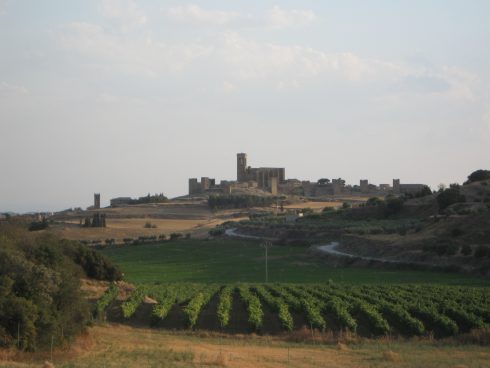
We were shown around Artajona by Town Hall employees Soco and Daniel, who generously showed us the imposing skyline from inside, outside and in all kinds of light and floodlight.
We were also introduced to some of the local people who participated in the making of the film, such as octogenarian Jerusalen Jurio, who explained to us how she had been one of ‘Nottingham’s’ market vendors, peeling the skin from a rabbit as though taking off a glove.
The castle besieged incompetently by Robin (Sean Connery) at the beginning and then pillaged irrationally by a psychotic King Richard (Richard Harris) was in reality Villalonso Castle in Zamora province.
Richard pays the price for his blood thirst when an old man ‘throws’ an arrow into his neck, causing his death the following day during a banquet held quite far away in the Palacio de Capitania, which is now the General Archive building of Navarra in Pamplona.
On our visit to the Archive we were shown around by Peio Monteano, who was well aware of the building’s movie use, having himself shown his in-laws from Wisconsin around the various local locations of the film.
I don’t know whether or not director Richard Lester knew that the Palace had originally belonged to Sancho el Sabio (the Wise), Richard Lionheart’s real life father-in-law, and that the display room representing the palace where Richard dies bears Sancho’s name, but it seemed too good a coincidence to be coincidence.
The famous, sensuous Spanish actress Victoria Abril plays Queen Isabella, King John’s child queen who occasionally isn’t thinking about sex, and Audrey Hepburn plays Marian, who gave up the life of the flesh when Robin left her and is willing to give up everything for him, even his life. Hepburn proved her impractical nature by driving a horse and cart laden with nuns into a river during filming, a genuine accident that remained in the film.
The river in question is the one that now surrounds the camp site at Urrobi, just south of Roncesvalles, where we were told by two local people that shooting took place.
Marian’s ‘Abbey’ was constructed especially for the film at the Urbasa mountain range, to the north west of Pamplona, where the final battle scene also took place.
Local expert Balbino García de Albizu informed us of the exact location of Hepburn’s convent, which was built at the Alto de Aranzaduia. This can be reached by taking the road from Zudaire on the southern side of the range, and at the top taking the left turn towards Vitoria for a couple of kilometres. It’s situated on the right.
Connery and Hepburn developed a close friendship during filming, and even attended the bull running at Pamplona’s San Fermín festival in July 1975.
In Cuba (1979) British ex-army officer Robert Dapes arrives on the island to advise the Batista government on fighting the revolutionaries, but he realises that the cause is already lost, with well organised rebels constantly gaining ground against poorly trained government troops. His difficulties are compounded when he runs into Alexandra, the love of his life who has settled for a comfortable marriage, which is now threatened by the revolution and by the exploits of her philandering husband.
At the beginning of the film, two suspects are being driven to a seaside fortress which in reality is the castle of San Sebastián in Cádiz harbour. So Cuban-looking is it in fact that it would be used again for the same function in the James Bond film ‘Die Another Day’.
Cádiz’s Plaza de España was used for the scene with the Havana crowds hailing Castro, and black marines from the nearby Rota Military Base helped to give the scene some authentic Havanan ethnicity.
The battle scenes in the cane field with the old steam train were shot at the mouth of the River Guadalhorce, using the famous Babwil 140 train, used in so many films. Martin Balsam’s troops are defeated among the reeds by Castro’s rebels.
Balsam plays the Cuban dictator Fulgencio Batista, who ironically would die among the authentic luxury of nearby Marbella in 1973.
Motril is also host to the tobacco factory that an American businessman is thinking of doing business with, and is in reality the Fabrica del Pilar, an old sugar factory where, in another scene, Sean Connery is taken prisoner by the rebels. These scenes also include some footage shot in the old tobacco factory of Cádiz, which has since been transformed into the Palacio de Congresos.
When Connery takes a young officer to ambush some guerrillas, the filming was done near the Camino del Canal around Monte Castillo known as the Era del Maíz, just above the aerodrome E.V.A 9, also at Motril.
When he arrives in Cuba, Connery is taken to a modern hotel, which he rejects for something with more ‘local colour.’ The hotel he rejected was Málaga’s Miramar Hotel, while the more down-market one he moves to is the Hotel Roma in Calle Real, Cádiz.
Another location in Cádiz was the Isla (Island) del Trocadero, while Málaga’s Town Hall and Plaza de San Juan de Dios also feature in the film.
Some equestrian elegance was provided by the Fundación Real Escuela Andaluza del Arte Equestre at Avenida Duque de Abrantes, Jerez de la Frontera. The Havana Yacht Club scenes were also shot in Jerez, using the swimming pool of the Five Star Hotel Jerez, Avenida Alcalde Álvaro Domecq, 35, where Connery actually stayed instead of the seedier Hotel Roma.
Perhaps the most curious scene in the film is the one in which Connery visits a police station (Comiseria de Policia) and walks past a row of cages holding prisoners. Behind them we can make out some children playing basketball. All very charming and probably typical of pre-Castro Cuban police stations, except that the scene was shot in the Padre Luis Coloma school in Jeréz de la Frontera where, presumably for budgetary reasons, they didn’t bother to close the school for filming.
The Return of the Musketeers (1989) begins at a tavern, where Roy Kinnear is attempting to steal his lunch. The tavern, as usual, was in the Cartuja at Talamanca de Jarama in the province of Madrid.
Looked at from another angle, Frank Finlay (Porthos’s) palace, looks remarkably similar to Versailles in ‘The Three Musketeers,’ and it is in fact once again La Granja palace near Segovia, this time with Finlay amusing himself on a small merry go round.
The same location is used for the scene where the Queen, Geraldine Chaplin, is playing around in a small chariot drawn by goats.
At the beginning, when Aramis is rescued from a windmill, where he has been caught with his trousers down again, El Escorial palace near Madrid is easily recognisable in the background as he makes his escape.
At another point the city of Toledo is clearly recognisable in the background with its dominating Alcázar castle, as the Musketeers ride off to righten wrong.
Manzanares el Real castle (Madrid) was modified for the film with the digging of a moat. The discovery of a bone during the digging halted the filming for a while until it was confirmed to be merely that of a dog. It is from this castle that the Duke of Beaufort is rescued.
The castle is also the scene of the film’s climax, with the musketeers hi-jacking a hot air balloon and using it to enter the castle for the final showdown, with swordfights all over and around the battlements and cloisters.
Other locations are Pedraza, where a hanging takes place, and the Valsaín forest, both in Segovia. In the forest the executioner is executed by Lady de Winter’s daughter.
She first comes up against the Musketeers, ironically, in the same location where they first get together and duel in The Three Musketeers, before they are four, in the Hospital de Talavera in Toledo, with its conspicuous double cloister.
The film is dedicated to Roy Kinnear, who on 19th September 1988, fell from a horse on the Alcantara bridge in Toledo, sustaining a broken pelvis. He was taken to hospital in Madrid, and died from a heart attack the following day. Richard Lester was greatly affected and gave up his own film career as a direct result of his friend Kinnear’s death.
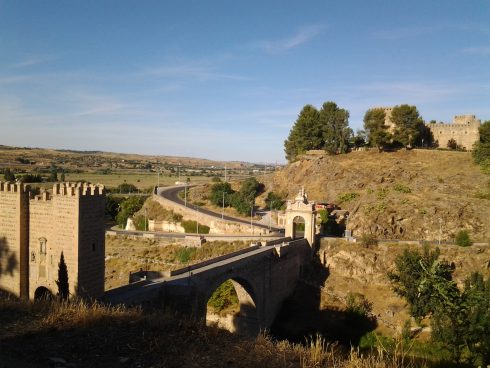
If you would like a copy of the text of Movies Made in Spain (all 690 pages) send me an e-mail to bobyareham@gmail.com

